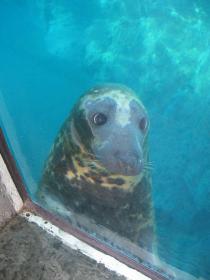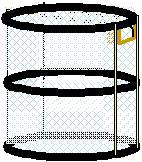
Introduction
Environmental enrichment has been widely used by zoos for many years for increasing species-specific behaviours in animals. The environmental enrichment adds ingredients that make the captive habitat more similar to the animals natural habitat, like for example different floor substrates and climbing opportunities. Food is a popular environmental enrichment because one can for example hide it in order to simulate foraging. Some scientists have also used live food, like fish when studying foraging and predatory behaviours in animals.
To find out what environmental enrichment an animal wants to have access to, is to make it pay a price. The price is in the form of time or energy spent when for example passing through a narrow gap or pushing through a weighted door.
To be able to assess the resource of interest it is necessary to compare it to a resource of known value. The comparator is often food since it varies predictably depending on how much the animal has already eaten and the time since the last meal. If then the resource of interest is equal to or higher than the comparator, it is said to be very important to the animal.
One way of ranking the importance of the resource an animal is willing to pay for are the maximum price paid approach. It measures the highest price an animal is willing to pay for only one visit to the resource, by increasing the price until the animal stops to pay.
Maximum price paid can be measured in two different ways: with a long session duration, for example the whole day; or a short session duration, for example one hour. Long sessions allow the animal to choose when to pay for the resource and this can be good since the animal may only have a motivation to use the resource at particular times a day. The short session is useful when looking at effects of deprivation or satiation levels.
If additional food is given to the animal outside the experiment the economy is said to be open, and if the animal is only given food during the session the economy is closed.
The aim with this study was to measure the motivation of grey (Halichoerus grypus) and harbour seal (Phoca vitulina vitulina) for getting access to live fish and artificial kelp. Artificial kelp had been an ad lib environmental enrichment to the seals at Kolmården zoo before this study and was seen being manipulated by the seals, but has never been investigated how much they used it and in what way. Live fish has never before been given to these seals and the purpose was to investigate if foraging and prey catching behaviour was a part of their natural behaviour repertoire that they wanted to be able to perform.

Material & Method
One female Baltic grey seal, Liivi, and one male harbour seal, Marcus, were used in this study. The live fish that was given to the seal were eel, pike, perch, whitefish, burbot, sculpin and flounder.
A large cylindrical net cage was used as the test arena. Three rings of PEM hose was the “skeleton” of the cage. The underwater entrance and exit gate was attached to the upper ring. The entrance gate had a float that could be filled with a controlled amount of air. In order to get inside the cage, the seal had to press down this gate, and the buoyancy of it determined the weight or price. The entrance gate could only be opened from the outside and the exit gate from the inside. The artificial kelp was made of a thick cellulose felt, a so called Vira fabric, which is used in the paper industry for drying paper pulp.
Liivi and Marcus were trained to enter and exit the cage. Marcus did not learn to enter or exit the cage, possibly because he was intimidated by Liivi, and could therefore not be used in the experiment.
Live fish was introduced to Liivi before the experimental trial with artificial kelp started. She did not, however, respond well to them and the trials with live fish had to be aborted.
Food was used as the comparator. Open economy was used during the comparator sessions because Liivi was given free food after every session and also was fed in the morning. Closed economy was used during the trials with artificial kelp since she was not allowed free access to the kelp outside the sessions. She was allowed one visit per day in the afternoon into the cage, with increasing weights every day. The weight schedule was 0, 10, 20, 30, 40, 45, 50, 55, 60 and 65kg.
Liivi had been without food in approximately 6 hours since her breakfast before the comparator sessions which were carried out in the afternoon.
The maximum price paid for artificial kelp was presented as percent of the willingness to pay for food.
Results
Liivi was prepared to work for the food. The weights from 0 to 20kg she managed without any apparent effort, but in the heaviest weight, 60kg, she had to work hard to get through the gate. She failed to get through when the weight was increased to 65kg. So her maximum price paid for food was 60kg.
Liivi’s maximum price paid for artificial kelp was 10kg, hence 17% of the maximum price paid for food.
Discussion
The deprivation period of 6 hours and her expectancy of food at this time in the afternoon would have contributed to her level of feeding motivation. It is probable that the motivation to enter the cage for food was moderate. Liivi worked deliberately and focussed to open the gate and in the four heaviest weights, 45, 50, 55 and 60kg, she made several attempts to open it before she manages to do so.
The results show that artificial kelp was not an attractive environmental enrichment for Liivi. There may be several reasons to why she wasn’t interested in the kelp. One reason might be that she had come into heat after giving birth to a stillborn half through the trials with artificial kelp. Because of this she seemed to have lost interest in almost everything except the male grey seal. It would probably have been better to start the trial until her reproductive period was completely over. A second reason can be that she might have forgotten what to expect in the cage due to a 10 days break in the experiment after given birth. therefore she was unwilling to pay a higher price for an unknown resource.
Conclusion
Liivi paid 10kg for artificial kelp, but the motivation was weak. She was not willing to pay anything for live fish. The circumstances outside the experiments indicate, however, that the results were not reliable.
Responsible for this page:
Director of undergraduate studies Biology
Last updated:
05/30/07
